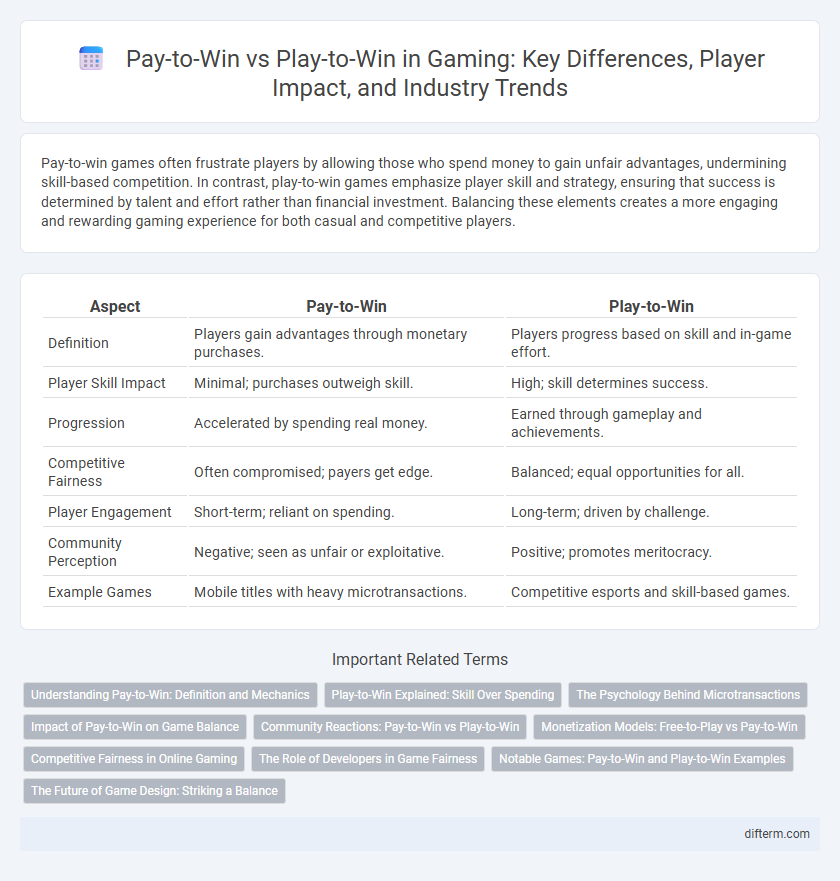Pay-to-win games often frustrate players by allowing those who spend money to gain unfair advantages, undermining skill-based competition. In contrast, play-to-win games emphasize player skill and strategy, ensuring that success is determined by talent and effort rather than financial investment. Balancing these elements creates a more engaging and rewarding gaming experience for both casual and competitive players.
Table of Comparison
| Aspect | Pay-to-Win | Play-to-Win |
|---|---|---|
| Definition | Players gain advantages through monetary purchases. | Players progress based on skill and in-game effort. |
| Player Skill Impact | Minimal; purchases outweigh skill. | High; skill determines success. |
| Progression | Accelerated by spending real money. | Earned through gameplay and achievements. |
| Competitive Fairness | Often compromised; payers get edge. | Balanced; equal opportunities for all. |
| Player Engagement | Short-term; reliant on spending. | Long-term; driven by challenge. |
| Community Perception | Negative; seen as unfair or exploitative. | Positive; promotes meritocracy. |
| Example Games | Mobile titles with heavy microtransactions. | Competitive esports and skill-based games. |
Understanding Pay-to-Win: Definition and Mechanics
Pay-to-win games allow players to gain competitive advantages by purchasing in-game items, resources, or boosts, creating a disparity between paying and non-paying users. This model often affects game balance and player experience by prioritizing financial investment over skill or strategy. Understanding the mechanics involves analyzing microtransactions, loot boxes, and premium currencies that influence progression and gameplay dynamics.
Play-to-Win Explained: Skill Over Spending
Play-to-win models emphasize player skill and strategy instead of monetary investment, creating a balanced gaming environment where success depends on mastery rather than spending. Unlike pay-to-win systems, which allow players to buy advantages, play-to-win games reward practice, tactical decisions, and in-game achievements. This approach promotes fairness, competitive integrity, and long-term engagement among players.
The Psychology Behind Microtransactions
Microtransactions exploit the psychology of reward anticipation, leveraging variable ratio reinforcement schedules to encourage continuous spending in pay-to-win models. Play-to-win systems emphasize skill and strategy development, fostering intrinsic motivation and sustained engagement without financial advantage. Understanding consumer behavior, such as loss aversion and the desire for status, is crucial in designing ethical monetization that balances profitability with player satisfaction.
Impact of Pay-to-Win on Game Balance
Pay-to-win mechanics disrupt game balance by giving paying players unfair advantages such as exclusive gear, faster progression, and power boosts, undermining skill-based competition. This imbalance often leads to frustration among non-paying players and reduces overall player retention, as skill and strategy become secondary to monetary investment. Game developers face challenges maintaining fairness and engagement while monetizing, making transparent design crucial to avoid alienating the core player base.
Community Reactions: Pay-to-Win vs Play-to-Win
Community reactions to pay-to-win models often highlight frustration due to perceived unfair advantages granted by microtransactions, undermining competitive balance and gameplay integrity. In contrast, play-to-win systems that reward skill and strategy foster positive engagement, driving sustained player loyalty and healthy in-game economies. Player feedback on forums and social media consistently favors transparent progression paths over monetized shortcuts, shaping industry trends towards fair competition.
Monetization Models: Free-to-Play vs Pay-to-Win
Free-to-play games generate revenue primarily through cosmetic items, battle passes, and optional in-game purchases that do not affect gameplay balance, preserving fairness and player engagement. Pay-to-win models monetize by selling power-ups, stronger characters, or advantages that can disrupt competitive integrity and create skill gaps influenced by spending. Choosing between these monetization strategies impacts player retention, community trust, and overall game longevity in the competitive gaming market.
Competitive Fairness in Online Gaming
Competitive fairness in online gaming hinges on the balance between pay-to-win and play-to-win models, where pay-to-win often undermines skill by allowing monetary advantages to dictate outcomes. Play-to-win systems emphasize player skill, strategy, and dedication, creating a level playing field that rewards expertise rather than financial investment. Maintaining this balance is crucial for preserving community trust, player retention, and the integrity of esports competitions.
The Role of Developers in Game Fairness
Game developers play a crucial role in maintaining fairness by designing balanced mechanics that prevent pay-to-win advantages, ensuring competitive integrity through transparent monetization strategies. Implementing skill-based matchmaking and equalizing reward systems fosters a play-to-win environment where player skill, rather than financial investment, determines success. Ongoing developer commitment to patching exploits and addressing community feedback strengthens fair gameplay and enhances player trust.
Notable Games: Pay-to-Win and Play-to-Win Examples
Pay-to-win games such as "Clash of Clans" and "Game of War" allow players to purchase powerful items or boosts, granting a significant advantage over others who rely solely on skill. Play-to-win titles like "Fortnite" and "League of Legends" emphasize player skill, strategy, and progression without requiring monetary investment for competitive success. These contrasting models shape player engagement and community dynamics across various gaming genres.
The Future of Game Design: Striking a Balance
Game developers are increasingly exploring balanced monetization models that avoid pay-to-win pitfalls while rewarding skill and strategy inherent in play-to-win designs. Integrating fair progression systems and competitive matchmaking ensures player retention and engagement without compromising game integrity. The future of game design hinges on creating equitable experiences that foster both revenue growth and community trust.
pay-to-win vs play-to-win Infographic

 difterm.com
difterm.com